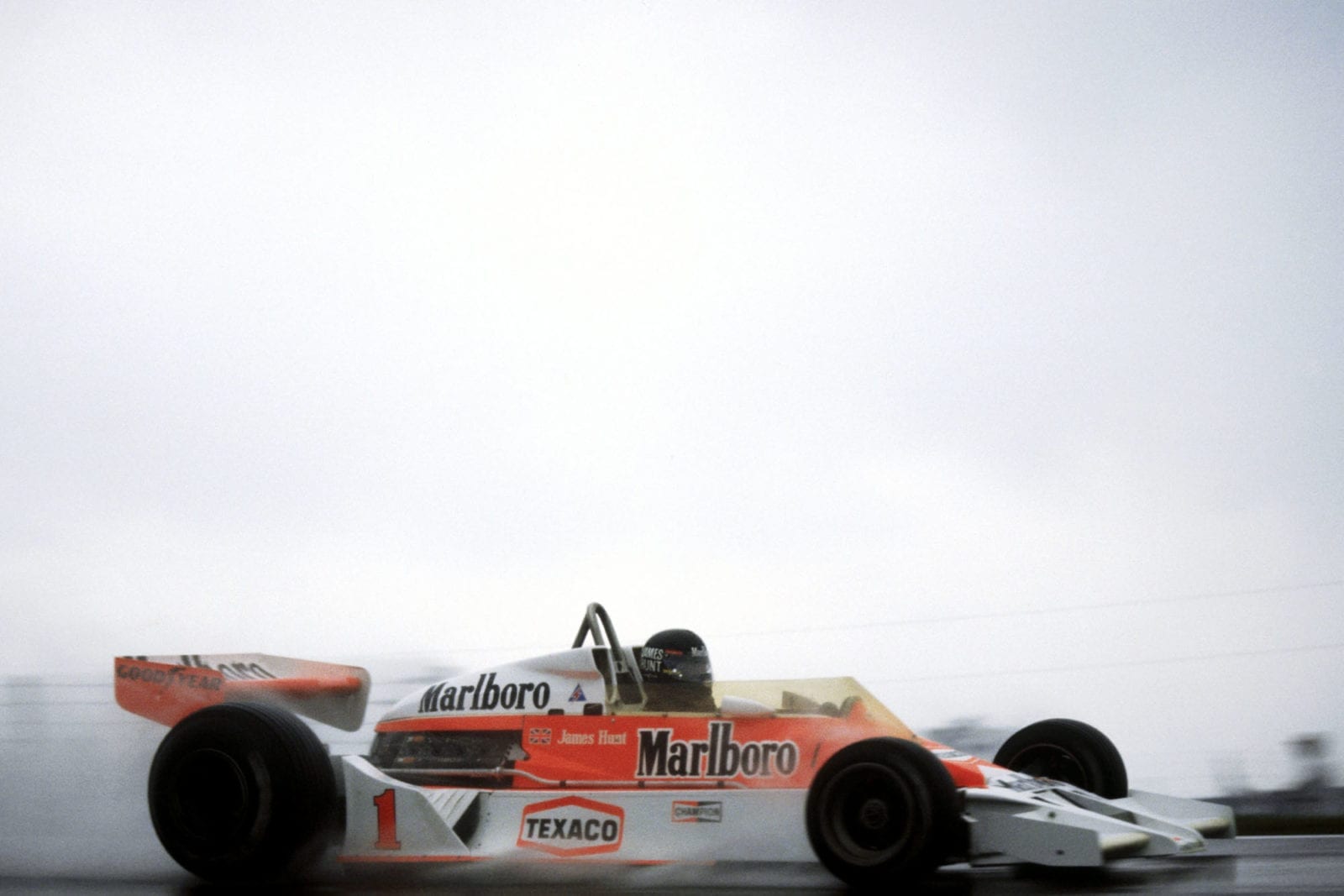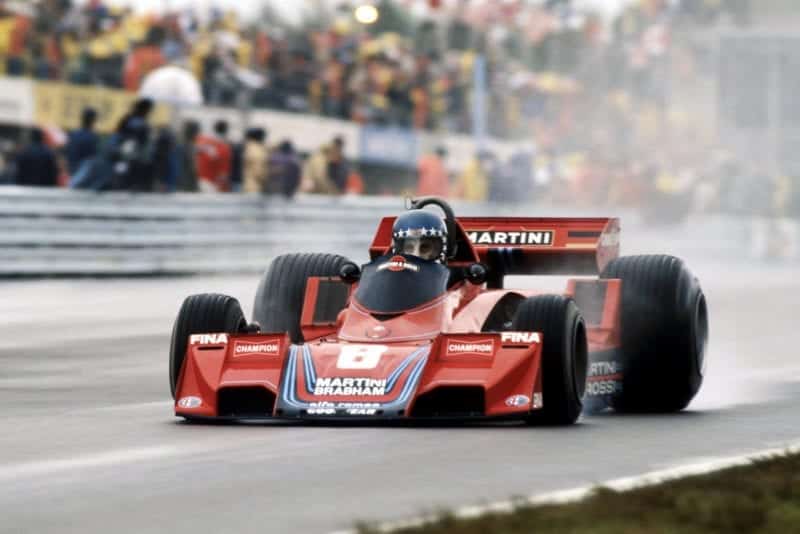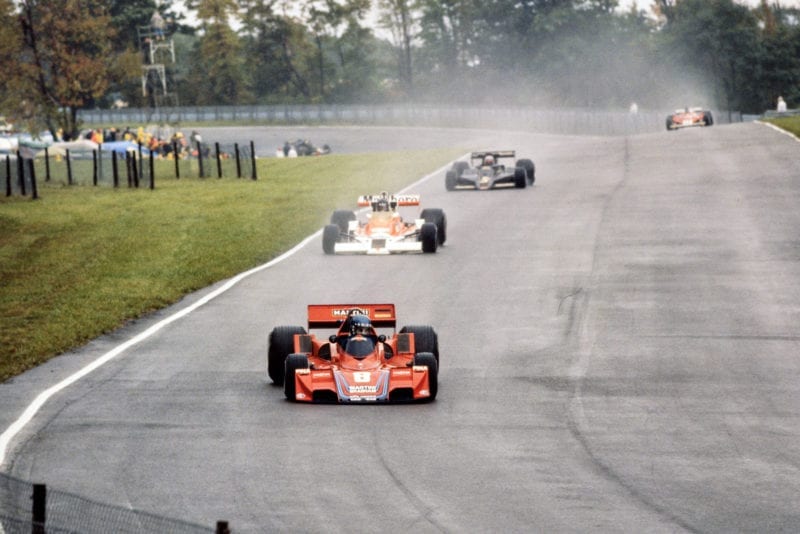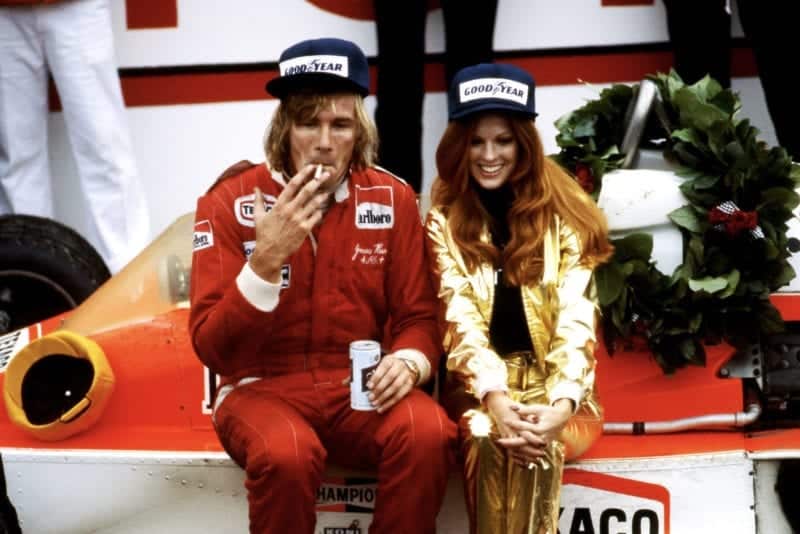1977 United States Grand Prix East race report

James Hunt prevailed in wet conditions to win
Motorsport Images
Hunt triumphs in the wet
Watkins Glen, New York, October 2nd.
The Formula One circus moved to North America at the end of September for the 15th and 16th rounds of the 1977 World Championship contest, made up of the United States Grand Prix at Watkins Glen on the weekend of October 1st/2nd and the Canadian Grand Prix at the Ontario circuit of Mospot Park on the weekend of October 8/9th. The two organisers shared the cost of transporting the Formula One cars across the Atlantic and, for the first time, in 1977 the “two race series” kicked off with the American event. Once the first race was finished a fleet of giant articulated long-distance lorries were loaded up with all the Grand Prix machine, and transported off to the next event.
Obviously local interest at Watkins Glen was centred round Italian Grand Prix winner Mario Andretti and his Lotus 78, not merely because he has been a regular winner this season, but because of the prospect of a “home” driver winning at Watkins Glen for the very first time. For Andretti, the race was similarly important for he not only wanted to win, but he wanted to achieve an unnofficial “double” and add victory at Watkins Glen to his early triumph this season at the “round the houses” United States Grand Prix West at the Californian city of Long Beach.
However, away from Andretti and the other regular competitors, there were one or two car and driver alterations to note at Watkins Glen. To start with Andretti’s team-mate Gunnar Nilsson was using Lotus 78/4, the chassis that has served as the spare car at most of the previous races, while the Brabham team had brought out BT45/6B for Watson to use after the Ulsterman had badly damaged the monocoque of BT45/5B in his kerb-jumping incident during the opening laps at Monza. There was a new Shadow DN8/6A to replace Patrese’s car (also damaged at Monza), but the young Italian driver was committed to driving his Formula Two Chevron-BMW in a European Championship round at Estoril in Portugal, so the team hired Jean-Pierre Jarier for the weekend. Jarier, a former full-time member of the Shadow team up until the end of last season, was available as the ATS Penske team didn’t make the trip to North America and as he was a known quantity to the Northampton-based organisation he seemed just the man for the job. Many people registered some surprise that the job didn’t go to Shadow director Jack Oliver, particularly in view of his competent “stand-in” performances in the Race of Champions and at the Swedish Grand Prix, but the Englishman didn’t make the trip to North America owing to “business commitments” at home in London.
In the Surtees team things seemed to have gone the full circle as far as the second TS19 was concerned and, after Leoni’s failure to qualify at Monza, the drive reverted to Austria’s Hans Binder who drove the car earlier in the season. Binder was using the refurbished TS19/01, now brought up to later specification using parts borrowed from TS19/07. Teats mate Brambilla had his usual Beta Tools TS 19/06 rebuilt after its excursion at Monza.
One totally new face in Formula One was American Formula 5000 and USAC driver Danny Ongais who had a brand new Penske PC4(03) built up to identical specification to those cars used by John Watson at the end of 1976. Entered and operated by Ted Field’s Interscope Racing (which run a Parnelli-DFX turbo for Ongais in USAC events), the team received some guidance from former Penske F1 team manager Heinz Hofer and were equipped with a pair of ex-Parnelli Cosworth DFVs with which to tackle the two North American events. Apart front Ongais, the only non-FICA “independent” entries to come to North America were Jabouille’s Renault RS01 (of course), Frank Williams’ private March 761 for Neve and the brace of nicely prepared B & S Fabrications McLaren M23s for tangents chose from.
Qualifying
Practice started in fine, but crisp, windy weather on Friday morning and, from the outset, James Hunt dominated the day in his customary McLaren M26/2. Hunt was on tremendous form and ended up the first hour and a half long session comfortably quickest with 1 min. 47.408 sec., beating Hans Stuck’s Brabham BT45B/3 into second place by over half a second. Mindful that the flat-12 Brabham-Alfas might prove a very strong threat on this fast circuit, Hunt trimmed his time to a superb 1 min. 40.863 sec. during the afternoon session and reckoned he could have gone even quicker when he dropped the M26’s right-hand wheels over the kerb as he came out of the left-hand “Turn 10” a short way before the pits. Rather than lift his right foot, Hunt attempted to power the McLaren out of trouble, but it simply spun round and skidded backwards off the circuit on the left-hand side of the road. The impact wasn’t very great and damage was confined to the right rear suspension plus a slightly rumpled corner of the monocoque.
The McLaren mechanics had the car repaired for Saturday’s practice but the onset of heavy rain meant that Hunt had to work no harder and his Friday efforts secured him pole position for Sunday’s 59-lap race.
In the Brabham camp both Stuck and Watson were proving extremely competitive, but it was the German driver who got really fired up to get closest to Hunt’s time on Friday afternoon. He managed a 1 min. 45.538 sec. best even though he was forced to take over the team spare BT45/1B to do it after some cracks appeared in the gearbox casing on his regular machine. Despite being worried about his BT45/5B’s worrying tendency of understeering madly on right hand corners and not left during the first session, Watson was roused by his team-mate’s efforts and recorded a respectable 1 min. 41.193 sec. best in the second session which was to guarantee him third place on the grid for the race.
Sadly, the Lotus camp didn’t emanate a very happy atmosphere at Watkins Glen. Having turned down a Ferrari contract in order that he should stay with Colin Chapman’s team, Andretti was distinctly less than impressed with rumours that his team-mate for next season might be Ronnie Peterson and not Gunnar Nilsson. In fact it would be closer to the truth to say that Andretti was livid; what’s more, not being a political animal for the sake of being political, “The racer’s racer” is one of those people who call a spade a spade “and not a bloody shovel!” As far as he was concerned, there was only room for “one prima donna”, as he put it, “in this team and I think the whole affair is ludicrous”. As Chapman sought to pour oil onto the troubled waters existing within his team it became clear that, no matter who was partnering Andretti in 1978, it certainly wouldn’t be Nilsson. Keeping his annoyance under control Andretti still managed to put in a very competitive best practice lap of 1 min. 41.481 sec for fourth place on the starting grid.

Stuck put his Brabham 2nd on the grid
Motorsport Images
Right behind Andretti came none other than Peterson, the Swedish “veteran” having decided to try and prove to everybody that there was nothing wrong with his driving that a decent racing car couldn’t put right. Throwing his Tyrrell six-wheeler round with tremendous determination, and remarking that its balance seemed better than ever, Peterson recorded a best of 1 min. 41.908 sec. and his team mate Depailler wasn’t too far behind with a 1 min. 42.238 sec. Sandwiched between the two Tyrrell machines were the Ferrari 312 T2s of Carlos Reutemann (030) on 1 min. 41.952 sec. and Niki Lauda (031) on 1 min. 42.089 sec. It was pretty obvious that Lauda was very much out of favour in this Italian team following his decision to leave at the end of the season and, as has happened so frequently to out-going Ferrari team members, life wasn’t being made exactly easy for him. It wasn’t that there was anything particularly wrong, it was just that the sympathetic relationship between driver and team had vanished. However, it was the general consensus of opinion that the Maranello management had gone a little too far when they effectively “suspended” Lauda’s mechanic Guoghi from working again on his car as from Sunday morning simply because he had also decided to leave the team at the end of the year and follow Lauda to Brabhams.
Jody Scheckter found himself working tremendously hard at the wheel of Wolf WR1, but all to no effect. The South African simply couldn’t pinpoint exactly where things were going wrong because he felt the car was performing extremely well; it just simply wouldn’t improve on a 1 min. 42.315 sec. best which he managed in Friday’s second session. Similarly Jacques Laffite was a little disappointed with life because he’d just go into the groove during Friday’s first session and lapped his Ligier JS7/02 in 1 min. 44.640 sec. only for its water pump to fail in the afternoon, forcing the Frenchman to change into the spare JS7/03 with which he failed to improve. Both Ligier-Matras were prepared to long-wheelbase specification.
Vittorio Brambilla qualified his Surtees 11th quickest with a 1 min. 42.786 sec. lap after a remarkably uneventful day of practice, but Nilsson had an absolutely miserable time in the second Lotus 78. During the first session he was plagued by spongy brakes and it was only right at the end that one of the rear brake pipes was found to be “ballooning”; it eventually flew off the caliper altogether, spraying brake fluid all over the place. It was subsequently replaced but Nilsson could only manage a best of 1 min. 42.815 sec. during the second session which put him well down the grid.
Jones emerged fastest of the Shadows with 1 min. 43.019 sec., established in the first session which put him just ahead of Jabouille in the turbocharged Renault V6 RS01 which went through its first day of practice with no mechanical problems whatsoever. Mass could only manage 1 min. 43.242 sec. with the second works McLaren M26 after problems with a water leak and the throttle linkage not opening fully, Jarier recorded 1 min. 43.516 sec. and then came Lunger after a promising performance in his private M23 on 1 min. 43.698 sec.
Emerson Fittipaldi again felt that progress was being made with the Copersucar FD05/1 but he was still a long way off a competitive time on 1 min. 43.938 sec. while Regazzoni was the sole Ensign representative to make the grid after a troubled Friday in MN07. He only participated in the first session because, as they were stripping the gearbox to change gear ratios for the second session, his mechanics found a pinion bearing on the verge of breaking up. Effecting repairs cost Clay the entire second session and, with the onset of Saturday’s rain, he had no chance of improving. As far as Tambay was concerned the whole weekend was an unmitigated disaster as a water leak on Ensign MN08 resulted in his car overheating in the first session, requiring an engine change in the second session and then blowing all its oil out during Saturday’s un-timed session after the oil tank drain plug fell out. Then it started raining, so the luckless Frenchman ended up 27th in a line-up for a 26 car start…
In the Hesketh camp Rupert Keegan started out using 308E/3 with a new double-deck rear wing and a six-speed gearbox for the first time, but he punctuated his first day’s efforts with a gentle spin into the guard rail and, after trying the spare 308E/1 on Saturday, opted to race the older chassis. Ian Ashley, still flying the Godfrey Bilton flag on his 308 E/2 qualified for his first Grand Prix this season with 1 min. 45.100 sec. The two Heskeths sandwiched Ian Sheckter’s works March 771/2 which the South African driver was to crash in Saturday’s un-timed morning session, leaving the Bicester mechanics with plenty of work to do in order to ready the car for the race. The last two rows of the grid were comprised of Ribeiro’s works March 761B, Neve, Binder and newcomer Ongais’ Penske which had been plagued with fuel system and plug problems on Friday.
After Saturday morning’s untimed session, the final hour was lost in a deluge of rain, but it is worth recording that Jones bravely set the fastest lap of 2 min. 07.127 sec. an average speed of over 95 m.p.h. which really was extremely impressive in the absolutely diabolical conditions. Stuck was next up on 2 min. 07.750 sec., while the remainder, headed by Peterson’s Tyrrell, were about five seconds slower at the very least.
Race

Stuck took the lead at the start
Motorsport Images
Sunday provided very little in the way of respite from the weather, and the skies clouded over ominously for most of the morning. Eventually it started raining once again and, by the time the cars came out on their warming up lap, the field was pretty well divided between slicks and deep-grooved rain covers. In the short time that they took to complete their warming-up lap the rain had increased quite noticeably, so only the Brabham team decided to gamble and Watson’s car started the race on slicks. Things might have been so very different if the Ulsterman’s car had started on rain tyres like its team-mate.
At the start Stuck rocketed into an immediate lead, his Brabham-Alfa edging into the first corner as the only car visible, the remainder of the grid being swallowed up in a wall of spray in his wake. Twitching over the puddles with great armfuls of opposite lock, Stuck looked as though he was positively enjoying the situation and he completed the opening lap of the race comfortably leading a Championship Grand Prix for the first time in his career. Hunt was second ahead of Andretti, then came Reutemann, Peterson, Lauda, Jody Scheckter, Laffite, Nilsson, Jones, Brambilla, Depailler, Mass, Regazzoni, Jarier, Watson (dropping back quickly on his slicks), Ashley, Keegan, Jabouille, Ongais, Lunger, Ian Scheckter, Binder, Fittipaldi, Ribeiro and Neve.
Second time round and Stuck was extending his lead slightly, Watson dropped back to last-but-one Just in front of Neve, Peterson dropped behind Scheckter and both Jones and Regazzoni were making up ground hand over fist. The Australian Shadow driver was really flying in the rain, confirming the form he’d demonstrated in the rain on Saturday. By the end of the third lap he was seventh, right on Peterson’s tail, but he didn’t come round again. Trying to pass the Tyrrell, Jones lost control of the Shadow and charged through the catch fencing into the guard rail, seriously damaging the monocoque of DN8/4A as he did so. Jones subsequently expressed the opinion that Peterson was rather more to blame for the incident than he was, and this was an opinion that we were to hear from several other drivers later in the race.
Stuck’s clutch operating mechanism failed on the third lap, but the young German driver pressed on in tremendous style as Hunt kept a watching brief in the Brabham, just out of spray’s distance. Ongais slid out of the race on lap seven. Mass stopped the second McLaren M26 with drowned electrics on lap nine and Ian Scheckter spun very violently into the chicane catch fencing on lap 11, emerging unhurt from his March 771 but writing the monocoque off in the process. Jody Schekter had quickly worked his way past Reutemann to consolidate fourth place, but Lauda and Regazzoni were also close behind the Argentinian’s Ferrari by the time the race reached the 10-lap mark.

Jody Scheckter brought his Wolf home in 3rd
Motorsport Images
Stuck’s superb performance lasted only until mid-way round his 15th lap. The Brabham BT45B apparently jumped out of gear as Stuck was rounding one of the Glen’s corners and in an instant Stuck was off the road is amongst the catch fencing. Hunt assumed the lead, driving his McLaren beautifully in the horrible conditions, and the English ace was never headed again all the way to the chequered flag, although that wasn’t exactly the whole story of the rest of the race!
For the next thirty laps or so, the leading half-dozen places were not subject of any major disruption. Hunt edged away from Andretti, building up a cushion of about 12 sec. on the Lotus team leader, Scheckter’s Wolf was third and Lauda through to fourth. Regazzoni took until lap 23 to displace Reutemann’s Ferrari for fifth place, although the second 312T2 was misfiring quite badly by this stage. Behind this group, however, there had been plenty of activity, mainly centring round Peterson’s Tyrrell.
On lap 18 Nilsson moved his Lotus up to challenge his compatriot for seventh place, moving his Lotus alongside the Tyrrell on the long back straight. Then, to Nilsson’s amazement, Peterson moved over on him, pushing him off the circuit and forcing him to spin down the road into retirement. Laffite was the next to have a try and the Frenchman later admitted that Ronnie pushed him onto the grass a couple of times as he attempted to pull alongside the six-wheeler. Eventually Laffite passed Peterson and pulled away from him on lap 21.
The other man to show a great deal of spirit in this race, although in his case the odds were stacked against him, was Watson. Realising the futility of his situation on slicks, he stopped at the end of lap eight to change onto rain tyres. He immediately began making up ground, pulling through to 19th place on lap 15, 16th place on lap 20, 15th place on lap 25, 13th place on lap 27, finally reaching 10th place at the end of lap 38 when he was obliged to stop for fresh tyres again. Undaunted, off he went again after dropping a single place, and got back to 10th before stopping for a third set of tyres at the end of lap 42. That dropped him to 14th place but he was back up to 12th at the end, despite the effects of a rapidly drying circuit in the race’s closing stages, after an afternoon of very hard work which reaped him precious little in the way of results.
The only other retirement in the race was that of the Renault which, after running reliably in 11th place, stopped on the circuit on lap 31 when the alternator drive from the gearbox broke and flattened the car’s battery. Peterson made two stops for fresh tyres, his Tyrrell being fitted with another set of wet weather covers after the team boss didn’t feel Ronnie was ready for slicks on lap 34. That was a shame, for Peterson was back five laps later, this time for slicks, and the combined effect of the two stops dropped him to an impossible 16th place by the end of the race.

Hunt celebrates his win
Motorsport Images
In the closing stages, with the track drying out, Hunt eased up to conserve his wet-weather tyres. But he was also worried about a soaring water-temperature gauge needle and what he thought to be a deflating rear tyre, so he eased off rather more than he’d intended and found Andretti within a couple of seconds of his McLaren as they went into the final lap. But Hunt wasn’t going to be ruffled at this late stage in the proceedings and came home a delighted winner of the United States Grand Prix for the second successive time by fractionally more than 2 sec. from the hard-trying Andretti. Third place fell to Scheckter, while Lauda set the seal on his second Championship title with a cautious fourth place in what was to be his last race with the Ferrari team, Reutemann finished sixth behind Regazzoni, the second Ferrari lapped by the winner before the finish, while Laffite was seventh and Keegan’s Hesketh a very promising eighth. Jarier survived to ninth while Lunger got the better of a race-long battle with Binder for 10th place shortly before the finish. From then on the finishing order read Watson, Fittipaidi, Depailler, Ribeiro, Peterson, Ashley (after a pit stop delayed another good drive) and Neve, lastly, Brambilla bought his Surtees through to the finish in a nose-less 19th place, five laps behind the winner. He’d made a pit stop to have a fresh nose section fitted early in the race, having lost the original during a spin. The radiators were so distorted that Vittorio could not continue even without a fresh nose section as the mounting brackets were so distorted that there was no way in which he could restart. Unabashed, the burley Italian leapt from the cockpit, pulled the radiator brackets straight with his bare hands and climbed back in again. The mechanics watched with amazement as Brambilla went on his way!
A.H.
